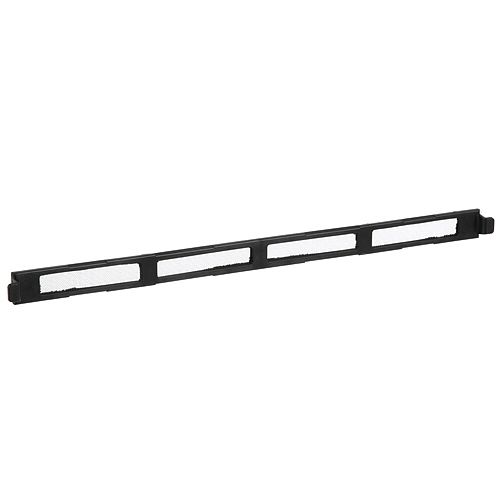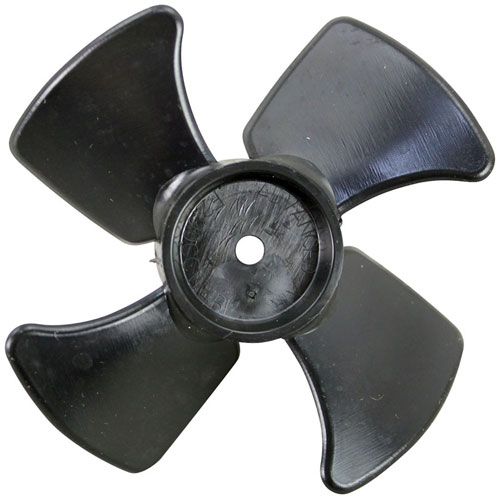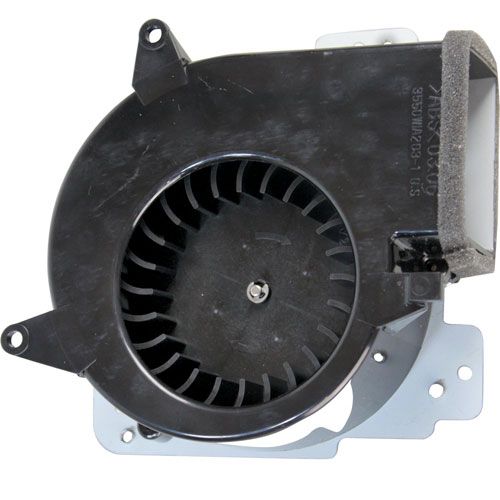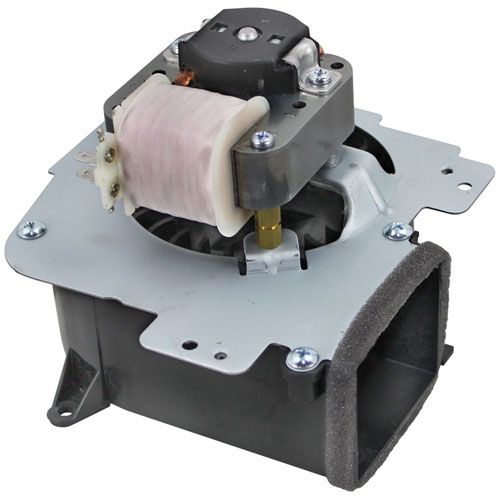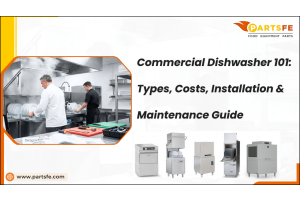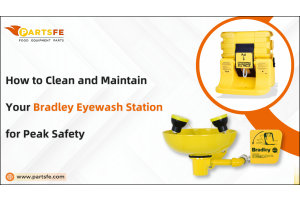Amana Refrigerator Parts Issues: Here's How to Fix Common Problems
Amana commercial refrigerators are a trusted choice for kitchens and restaurants, known for their reliability and durability. However, like all appliances, refrigerators can experience wear and tear over time. As a restaurant owner or kitchen manager, it’s crucial to keep your equipment running smoothly to maintain the efficiency of your kitchen and meet health standards. This guide will walk you through common Amana refrigerator parts issues and how to fix them, ensuring that your refrigerator operates at its peak.
Common Signs of Failing Amana Refrigerator Parts
Recognizing early signs of failing commercial Amana refrigerator parts can save you from expensive repairs or even the need for a full replacement. The following signs indicate your refrigerator requires maintenance:
-
Inconsistent Cooling: If your refrigerator’s temperature is inconsistent, it may indicate a problem with the thermostat, condenser coils, or fan motor.
-
Strange Noises: Unusual sounds like buzzing, clicking, or grinding noises can point to issues with the compressor, fan, or motor.
-
Water Pooling: Water leakage or pooling inside or outside the refrigerator occurs because of clogged defrost drains or faulty door seals, or drainage problems.
-
Frost Buildup: If frost is forming inside the freezer or refrigerator compartment, it is often a sign of a defective door seal or evaporator fan.
-
Excessive Energy Consumption: If your electricity bills are rising without a clear explanation, a malfunctioning part, such as the condenser coils or compressor, may be the reason.
-
Ice Maker Not Working: If your Amana refrigerator’s ice maker isn’t dispensing ice or producing enough ice, this could point to issues with the water filter, valve, or even the control board.
If you notice any of these issues, it's time to inspect and potentially replace some parts to restore your commercial refrigerator's functionality.
Are you struggling with Amana commercial refrigerator issues? PartsFe has you covered with high-quality replacement parts from top brands like Amana, AllPoints, Continental, and Hobart. Find the right components like evaporator fans, defrost timers, water inlet valves, and thermostats to fix common problems quickly and keep your appliance running smoothly.
Troubleshooting Amana Refrigerator Door Seal Problems
A worn or damaged Amana refrigerator door seal is one of the most common causes of temperature fluctuations and inefficient operation. A step-by-step guide exists for identifying regular problems and performing rapid resolutions.
Cracked or Torn Door Seal
Cause: Constant door use can crack or tear the rubber seal, allowing cold air to escape and reducing efficiency.
Solution: Clean the door seal using a mild detergent and warm water. A soft cloth should be used to clean away dust and debris. Regularly cleaning the seal will help maintain its effectiveness and ensure the refrigerator stays at the correct temperature.
Misaligned Door
Cause: A misaligned door can prevent the seal from closing properly, leading to air leaks and inefficient cooling..
Solution: Verify that the refrigerator door sits correctly in its position. If it's uneven, adjust the door’s hinges so it closes securely, allowing the seal to make full contact with the frame. Proper alignment ensures the refrigerator runs efficiently.
Temperature Inconsistency
Cause: Slamming the door or heavy use can compress the seal, causing it to lose flexibility and fail to maintain a tight seal.
Solution: If the door seal appears to be compressed or flattened, replace it with a new one. A high-quality, flexible seal will restore the refrigerator’s ability to maintain the ideal temperature and reduce the strain on the compressor.
Dirty or Stiff Door Seal
Cause: Accumulation of food debris or grime prevents the door seal from forming a tight, airtight seal.
Solution: Clean the door seal using a mild detergent and warm water. A clean, soft cloth allows people to erase dirt and excess materials. Regularly cleaning the seal will help maintain its effectiveness and ensure the refrigerator stays at the correct temperature.
Seal Contamination
Cause: Harsh cleaning chemicals or abrasive materials can damage the seal, weakening its ability to seal properly.
Solution: Use gentle, non-abrasive cleaners and a soft cloth to clean the door seal, avoiding harsh chemicals that can damage the rubber. Regularly inspect for signs of wear or damage and replace if needed.
Check out this guide on fixing common Continental refrigerator problems for more troubleshooting tips.
Fixing Temperature Fluctuations with New Amana Refrigerator Parts
Temperature fluctuations in your commercial Amana refrigerator parts can cause food spoilage and impact food safety. These fluctuations often result from faulty components.
Door Seal Leaking
Cause: A broken or worn door seal creates an entry point for warm air, which makes the refrigerator work more intensely to maintain its cool temperature.
Fix: Replace the damaged door seal with a fresh, high-quality one. A new seal creates a tight door seal that maintains cold air inside and prevents warm air from entering. The new door seal allows you to experience efficient cooling while eliminating temperature fluctuations.
Amana Refrigerator Condenser Fan
Cause: Dirt, dust, or a malfunctioning motor can prevent the condenser fan from spinning, disrupting the airflow needed to maintain proper cooling.
Fix: Clean the fan or replace it if needed. A properly functioning fan circulates air efficiently, ensuring your refrigerator operates at the right temperature and reducing strain on the system.
Malfunctioning Thermostat
Cause: A faulty thermostat may fail to detect the correct temperature, causing the fridge to overcool, which leads to food spoilage.
Fix: Replacing the thermostat restores accurate temperature regulation. A new thermostat helps keep your fridge at the right temperature, preserving your food and reducing energy waste.
Frozen Evaporator Coils
Cause: A malfunctioning defrost system or blocked air vents can cause ice buildup on the evaporator coils, disrupting proper airflow and cooling.
Fix: Defrost the coils and check the defrost thermostat or heater. Replacing any faulty parts ensures efficient air circulation and consistent temperature control.
Faulty Fan Motor
Cause: A malfunctioning fan motor can disrupt airflow, leading to inconsistent cooling inside the fridge and freezer.
Fix: Replace the fan motor to restore proper airflow and consistent temperature distribution throughout the appliance.
Solving Water Dispenser and Ice Maker Issues in Amana Refrigerators
Amana refrigerator water dispenser and ice maker problems are not uncommon in commercial Amana refrigerators. These components rely on several small parts that can wear out or get clogged over time.
Common Water Dispenser and Ice Maker Issues:
-
Clogged Water Filter: A clogged filter can impede water flow or stop it entirely, affecting both the water dispenser and ice maker.
-
Ice Maker Not Producing Ice: The water dispenser stops working due to three main reasons: a faulty water inlet valve, motor failure or frozen water supply lines.
-
Water Dispenser Not Working: A nonfunctional dispenser occurs when the water valve malfunctions or the lines freeze or the dispenser switch breaks.
How to Fix it:
-
Replace the Water Filter: To ensure proper water flow and avoid clogging, regularly replace the water filter. A fresh filter will improve performance and water quality.
-
Inspect the Water Inlet Valve: The water inlet valve should be inspected for blockages or damage because these issues might stop the ice maker from working properly.
-
Clear Frozen Lines: Frozen water lines can be resolved by defrosting them, restoring normal water and ice flow.
-
Test the Ice Maker Motor: If the motor is faulty, replacing it will restore the ice maker’s functionality, ensuring you always have ice on hand.
How to Handle Noisy Amana Refrigerator Compressors and Fans
A noisy refrigerator can be disruptive, especially in a busy commercial kitchen. If your Amana refrigerator compressor or fan is making strange noises, it may be time to inspect the parts for any damage.
-
Identify the Noise: Start by identifying whether the noise originates from the compressor system or the fan unit. A buzzing or clicking sound typically signals a compressor issue, while a whirring or grinding noise is usually from the fan.
-
Check the Compressor: If the compressor is noisy, it might be struggling due to dirt or debris buildup. Clean the area around the compressor and ensure there are no obstructions.
-
Inspect the Fans: A noisy evaporator fan could be caused by dirt buildup or a damaged motor. Check for any debris clogging the fan blades and clean them thoroughly.
-
Tighten Loose Parts: Loose parts or components can cause rattling sounds. Ensure all screws and components, including fan blades and compressor mounts, are tightly secured.
-
Lubricate the Fan Motor: A noisy fan motor develops when there is not enough lubrication. Apply a few drops of appropriate lubricant to the fan motor to reduce friction and restore quieter operation.
Replacing Amana Refrigerator Shelves, Drawers, and Bins
In a commercial kitchen, Amana refrigerator shelves, drawers, and bins can wear out over time. Replacing damaged parts with Amana refrigerator replacement parts keeps your fridge running efficiently.
Signs of Broken or Damaged Shelves:
-
Cracks or Chips: Over time, heavy items or rough handling can cause Amana refrigerator shelves and drawers to crack or break. This can lead to unstable storage.
-
Difficulty Sliding: If Amana refrigerator drawers become misaligned or worn down, they may stick or become hard to open and close.
-
Lack of Support: If Amana refrigerator bins no longer provide adequate support, heavier items may cause them to bow or collapse, creating a safety hazard or disrupting storage capacity.
How to Replace It:
To address these issues, follow these steps:
-
Remove the Damaged Parts: Carefully take out the broken shelf, drawer, or bin from its designated track or mounting points. Be gentle to avoid damaging other components.
-
Measure Before Ordering: Ensure that you have the correct measurements for the shelves and bins you need to replace. Different models may have varying sizes.
-
Order Replacement Parts: Ensure you order the correct Amana refrigerator parts for your specific model. Check the model number to match compatible shelves and drawers.
-
Install the New Parts: Slide the new parts into place, ensuring they fit securely in their designated spots. Check that all shelves and drawers operate without resistance while bearing the weight of heavy objects.
Read more about whether it’s better to repair or replace a refrigerator to ensure the longevity and proper functionality of your refrigerator.
Tips for Finding the Best Amana Refrigerator Parts for Repairs
When repairing and choosing the right parts for your Amana refrigerator, it's crucial to ensure optimal performance and longevity. Here are some tips for finding the best replacement parts:
-
Buy from Authorized Dealers: Always purchase from certified Amana parts dealers or the manufacturer to ensure you’re getting genuine, high-quality parts.
-
Match the Model Number: Make sure you know the exact model number of your refrigerator to ensure compatibility when ordering parts.
-
Consider OEM Parts: Original equipment manufacturer (OEM) parts are meant to be more durable and reliable than generic alternatives.
-
Check Reviews: Before purchasing, read customer reviews to ensure the parts you're buying are of good quality and work well with your fridge model.
-
Consult a Professional: If you're unsure about which part to replace or if you're dealing with a complex issue, it’s always best to consult with a professional repair technician.
Check out this guide on cleaning commercial refrigerator condenser coils to learn how to extend the life of your commercial refrigerator.
Proper maintenance of your commercial refrigerator determines its operational longevity while maintaining peak performance. Whether it's fixing temperature fluctuations, handling noisy compressors, or replacing shelves and bins, addressing issues early can prevent costly repairs and improve efficiency. Regular cleaning, proper maintenance, and replacing faulty parts when necessary will keep your fridge running smoothly, reduce energy consumption, and extend its lifespan. By staying proactive and using genuine Amana refrigerator parts, you can enjoy a reliable and well-functioning appliance for years to come.
FAQs
What is the average lifespan of an Amana refrigerator?
The average lifespan of an Amana refrigerator is around 10 to 15 years with proper care and maintenance. Regular servicing and timely repairs can extend its longevity.
Are Amana refrigerators reliable?
Yes, Amana refrigerators are known for their reliability and durability, making them a popular choice for commercial use.
What causes the Amana refrigerator to stop cooling?
Several factors can cause an Amana refrigerator to stop cooling, such as a malfunctioning compressor, dirty condenser coils, or a faulty thermostat. Issues with the door seal or refrigerant levels can also affect cooling efficiency.


